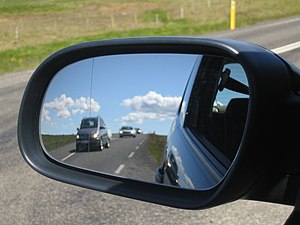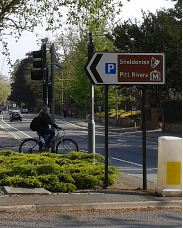[caption id="" align="alignright" width="240"] Central London Traffic (Photo credit: oatsy40)[/caption]
Driving through London a day or two ago, I was amazed to see in front of me an advertising van unlike any I had ever seen before. Half of the back of the van was taken up with a large screen, repeatedly showing a short advertising video clip, obviously in full view of the drivers behind. It certainly got my attention!
Call me old-fashioned, but this seemed to me to be an innovation too far. Driving in London is hard enough, with heavy traffic, bicycles, pedestrians, buses stopping and starting, complex road layouts etc. to pay attention to, without adding advertising which is so clearly going to distract drivers. Health and Safety rules have a bad reputation, but this seemed to me to be something they really should apply to.
But it did remind me that if you want something to grab someone’s attention, you should make it move! Years ago (even before the first PCs), I was a University Lecturer, and had to put on a display of some research for an open day. Nearly all the displays people made were static. Even though my subject was hard to make exciting for the public, and though my animated display on an early computer screen was small and very crude (in those days anything more would have been very hard), the fact that it moved and had a very simple coordinated sound track attracted far more visitors than most other displays.
Central London Traffic (Photo credit: oatsy40)[/caption]
Driving through London a day or two ago, I was amazed to see in front of me an advertising van unlike any I had ever seen before. Half of the back of the van was taken up with a large screen, repeatedly showing a short advertising video clip, obviously in full view of the drivers behind. It certainly got my attention!
Call me old-fashioned, but this seemed to me to be an innovation too far. Driving in London is hard enough, with heavy traffic, bicycles, pedestrians, buses stopping and starting, complex road layouts etc. to pay attention to, without adding advertising which is so clearly going to distract drivers. Health and Safety rules have a bad reputation, but this seemed to me to be something they really should apply to.
But it did remind me that if you want something to grab someone’s attention, you should make it move! Years ago (even before the first PCs), I was a University Lecturer, and had to put on a display of some research for an open day. Nearly all the displays people made were static. Even though my subject was hard to make exciting for the public, and though my animated display on an early computer screen was small and very crude (in those days anything more would have been very hard), the fact that it moved and had a very simple coordinated sound track attracted far more visitors than most other displays.
 Central London Traffic (Photo credit: oatsy40)[/caption]
Driving through London a day or two ago, I was amazed to see in front of me an advertising van unlike any I had ever seen before. Half of the back of the van was taken up with a large screen, repeatedly showing a short advertising video clip, obviously in full view of the drivers behind. It certainly got my attention!
Call me old-fashioned, but this seemed to me to be an innovation too far. Driving in London is hard enough, with heavy traffic, bicycles, pedestrians, buses stopping and starting, complex road layouts etc. to pay attention to, without adding advertising which is so clearly going to distract drivers. Health and Safety rules have a bad reputation, but this seemed to me to be something they really should apply to.
But it did remind me that if you want something to grab someone’s attention, you should make it move! Years ago (even before the first PCs), I was a University Lecturer, and had to put on a display of some research for an open day. Nearly all the displays people made were static. Even though my subject was hard to make exciting for the public, and though my animated display on an early computer screen was small and very crude (in those days anything more would have been very hard), the fact that it moved and had a very simple coordinated sound track attracted far more visitors than most other displays.
Central London Traffic (Photo credit: oatsy40)[/caption]
Driving through London a day or two ago, I was amazed to see in front of me an advertising van unlike any I had ever seen before. Half of the back of the van was taken up with a large screen, repeatedly showing a short advertising video clip, obviously in full view of the drivers behind. It certainly got my attention!
Call me old-fashioned, but this seemed to me to be an innovation too far. Driving in London is hard enough, with heavy traffic, bicycles, pedestrians, buses stopping and starting, complex road layouts etc. to pay attention to, without adding advertising which is so clearly going to distract drivers. Health and Safety rules have a bad reputation, but this seemed to me to be something they really should apply to.
But it did remind me that if you want something to grab someone’s attention, you should make it move! Years ago (even before the first PCs), I was a University Lecturer, and had to put on a display of some research for an open day. Nearly all the displays people made were static. Even though my subject was hard to make exciting for the public, and though my animated display on an early computer screen was small and very crude (in those days anything more would have been very hard), the fact that it moved and had a very simple coordinated sound track attracted far more visitors than most other displays.
Change gets peoples' attention!
Change is like that too. It moves, so it gets peoples' attention, unfortunately more often negatively than positively – like the advertising van did for me. But if you can find a way to make people curious, and if possible engage them in the exploration of the change, the results can be quite different! What is leadership about? The very word implies movement. Leadership involves helping other people to find the way from A to B, so all leadership is change leadership of some kind. If we are sticking to A, the people may need managing, but there is not much leading involved. You don’t need a leader if you are not going anywhere.
How many times have you heard people say “if its not broken, why fix it?” Probably you have said it yourself at times. Or “I don’t want to upset the apple cart”? No-one likes change – everyone is more comfortable with the status quo. The trouble is, stability is an illusion, at least in the longer term. Everything grows - or it declines. The organisation that does not change positively is doomed eventually to change negatively.
Change is the whole point of leadership. The joke says “How many psychologists does it take to change a light bulb? One, but it has to want to change!” The job of the leader is to have the vision of where to go to, and then to get people to the point where they want to, or at least accept the need for, change.
What is leadership about? The very word implies movement. Leadership involves helping other people to find the way from A to B, so all leadership is change leadership of some kind. If we are sticking to A, the people may need managing, but there is not much leading involved. You don’t need a leader if you are not going anywhere.
How many times have you heard people say “if its not broken, why fix it?” Probably you have said it yourself at times. Or “I don’t want to upset the apple cart”? No-one likes change – everyone is more comfortable with the status quo. The trouble is, stability is an illusion, at least in the longer term. Everything grows - or it declines. The organisation that does not change positively is doomed eventually to change negatively.
Change is the whole point of leadership. The joke says “How many psychologists does it take to change a light bulb? One, but it has to want to change!” The job of the leader is to have the vision of where to go to, and then to get people to the point where they want to, or at least accept the need for, change.
[caption id="" align="alignright" width="300"] Tyrannosaurus rex, Palais de la Découverte, Paris (Photo credit: Wikipedia)[/caption]
Evolution is the natural process by which all forms of life adapt to changes in their environment. It is a very slow process, in which many small changes gradually accumulate. It is unplanned and undirected: who knows how the environment may change in the future, and so what adaptations would put us ahead of the game? Successful changes are not necessarily the best possible choices, merely the best of those that were tested. Different individuals start from different places, and so the adaptations which seem to work will vary. Consequently, over time, divergence will occur until different species result, even though each species can be traced back to a common ancestor. But evolution is brutal too: not all species will make it. Some find they have gone down an evolutionary dead end, and some that change is simply too fast for them to adapt to.
Sometimes organisational change can be like this. I once worked for a public-sector organisation which was privatised, so that it had to change from being ‘mission-led’ to being profit-led. Management set out a vision for what it wanted the organisation to become – essentially a similar, unitary, organisation but in the private sector – but was unable to make the radical changes necessary to deliver it fast enough. Evolution carried on regardless as the primary need to survive forced short-term decisions which deviated from the vision. Without a unifying mission as a common guide, different parts of the organisation evolved in different ways to adapt to their own local environments. Fragmentation followed, with a variety of different destinies for the parts, and a few divisions falling by the wayside. Despite starting down their preferred route of unitary privatisation, the eventual destination was exactly what the original managers had been determined to avoid.
What is the lesson? Ideally of course it should be possible to set out a strategic objective, and then to deliver the changes needed to get there. But if the change required is too great, or the barriers mean change is brought about too slowly, the short-term decisions of evolution may shape the future without regard to management intentions. That does not necessarily make the outcome worse in the greater scheme of things: after all, evolution is about survival of the fittest. But natural selection is an overwhelming force, and if short-term decisions are threatening to de-rail management’s strategic plan, it may be wise to take another look at the plan, and to try to work with evolution rather than against it.
Tyrannosaurus rex, Palais de la Découverte, Paris (Photo credit: Wikipedia)[/caption]
Evolution is the natural process by which all forms of life adapt to changes in their environment. It is a very slow process, in which many small changes gradually accumulate. It is unplanned and undirected: who knows how the environment may change in the future, and so what adaptations would put us ahead of the game? Successful changes are not necessarily the best possible choices, merely the best of those that were tested. Different individuals start from different places, and so the adaptations which seem to work will vary. Consequently, over time, divergence will occur until different species result, even though each species can be traced back to a common ancestor. But evolution is brutal too: not all species will make it. Some find they have gone down an evolutionary dead end, and some that change is simply too fast for them to adapt to.
Sometimes organisational change can be like this. I once worked for a public-sector organisation which was privatised, so that it had to change from being ‘mission-led’ to being profit-led. Management set out a vision for what it wanted the organisation to become – essentially a similar, unitary, organisation but in the private sector – but was unable to make the radical changes necessary to deliver it fast enough. Evolution carried on regardless as the primary need to survive forced short-term decisions which deviated from the vision. Without a unifying mission as a common guide, different parts of the organisation evolved in different ways to adapt to their own local environments. Fragmentation followed, with a variety of different destinies for the parts, and a few divisions falling by the wayside. Despite starting down their preferred route of unitary privatisation, the eventual destination was exactly what the original managers had been determined to avoid.
What is the lesson? Ideally of course it should be possible to set out a strategic objective, and then to deliver the changes needed to get there. But if the change required is too great, or the barriers mean change is brought about too slowly, the short-term decisions of evolution may shape the future without regard to management intentions. That does not necessarily make the outcome worse in the greater scheme of things: after all, evolution is about survival of the fittest. But natural selection is an overwhelming force, and if short-term decisions are threatening to de-rail management’s strategic plan, it may be wise to take another look at the plan, and to try to work with evolution rather than against it.
 Tyrannosaurus rex, Palais de la Découverte, Paris (Photo credit: Wikipedia)[/caption]
Evolution is the natural process by which all forms of life adapt to changes in their environment. It is a very slow process, in which many small changes gradually accumulate. It is unplanned and undirected: who knows how the environment may change in the future, and so what adaptations would put us ahead of the game? Successful changes are not necessarily the best possible choices, merely the best of those that were tested. Different individuals start from different places, and so the adaptations which seem to work will vary. Consequently, over time, divergence will occur until different species result, even though each species can be traced back to a common ancestor. But evolution is brutal too: not all species will make it. Some find they have gone down an evolutionary dead end, and some that change is simply too fast for them to adapt to.
Sometimes organisational change can be like this. I once worked for a public-sector organisation which was privatised, so that it had to change from being ‘mission-led’ to being profit-led. Management set out a vision for what it wanted the organisation to become – essentially a similar, unitary, organisation but in the private sector – but was unable to make the radical changes necessary to deliver it fast enough. Evolution carried on regardless as the primary need to survive forced short-term decisions which deviated from the vision. Without a unifying mission as a common guide, different parts of the organisation evolved in different ways to adapt to their own local environments. Fragmentation followed, with a variety of different destinies for the parts, and a few divisions falling by the wayside. Despite starting down their preferred route of unitary privatisation, the eventual destination was exactly what the original managers had been determined to avoid.
What is the lesson? Ideally of course it should be possible to set out a strategic objective, and then to deliver the changes needed to get there. But if the change required is too great, or the barriers mean change is brought about too slowly, the short-term decisions of evolution may shape the future without regard to management intentions. That does not necessarily make the outcome worse in the greater scheme of things: after all, evolution is about survival of the fittest. But natural selection is an overwhelming force, and if short-term decisions are threatening to de-rail management’s strategic plan, it may be wise to take another look at the plan, and to try to work with evolution rather than against it.
Tyrannosaurus rex, Palais de la Découverte, Paris (Photo credit: Wikipedia)[/caption]
Evolution is the natural process by which all forms of life adapt to changes in their environment. It is a very slow process, in which many small changes gradually accumulate. It is unplanned and undirected: who knows how the environment may change in the future, and so what adaptations would put us ahead of the game? Successful changes are not necessarily the best possible choices, merely the best of those that were tested. Different individuals start from different places, and so the adaptations which seem to work will vary. Consequently, over time, divergence will occur until different species result, even though each species can be traced back to a common ancestor. But evolution is brutal too: not all species will make it. Some find they have gone down an evolutionary dead end, and some that change is simply too fast for them to adapt to.
Sometimes organisational change can be like this. I once worked for a public-sector organisation which was privatised, so that it had to change from being ‘mission-led’ to being profit-led. Management set out a vision for what it wanted the organisation to become – essentially a similar, unitary, organisation but in the private sector – but was unable to make the radical changes necessary to deliver it fast enough. Evolution carried on regardless as the primary need to survive forced short-term decisions which deviated from the vision. Without a unifying mission as a common guide, different parts of the organisation evolved in different ways to adapt to their own local environments. Fragmentation followed, with a variety of different destinies for the parts, and a few divisions falling by the wayside. Despite starting down their preferred route of unitary privatisation, the eventual destination was exactly what the original managers had been determined to avoid.
What is the lesson? Ideally of course it should be possible to set out a strategic objective, and then to deliver the changes needed to get there. But if the change required is too great, or the barriers mean change is brought about too slowly, the short-term decisions of evolution may shape the future without regard to management intentions. That does not necessarily make the outcome worse in the greater scheme of things: after all, evolution is about survival of the fittest. But natural selection is an overwhelming force, and if short-term decisions are threatening to de-rail management’s strategic plan, it may be wise to take another look at the plan, and to try to work with evolution rather than against it.
[caption id="" align="alignright" width="300"] Wing mirror VW Fox (Photo credit: Wikipedia)[/caption]
Last week I had to drive my daughter to France to start a year of study at a French University. As you can imagine, the (small) car was packed to the roof with all the things she needed, or at least believed she needed, and which could not possibly get there any other way. Result – the rear view mirror only gave me a view of some pillows, which was not a lot of help. However, I very quickly adjusted to relying entirely on the wing mirrors, and felt reasonably safe even though I was driving on the ‘wrong’ side of the road.
The strange thing was that on the return journey, having unloaded in Nantes, I continued in the same way. It was only chance that I glanced in the direction of the main mirror, and realised that it was (of course) no longer obstructed. Information inertia!
Wing mirror VW Fox (Photo credit: Wikipedia)[/caption]
Last week I had to drive my daughter to France to start a year of study at a French University. As you can imagine, the (small) car was packed to the roof with all the things she needed, or at least believed she needed, and which could not possibly get there any other way. Result – the rear view mirror only gave me a view of some pillows, which was not a lot of help. However, I very quickly adjusted to relying entirely on the wing mirrors, and felt reasonably safe even though I was driving on the ‘wrong’ side of the road.
The strange thing was that on the return journey, having unloaded in Nantes, I continued in the same way. It was only chance that I glanced in the direction of the main mirror, and realised that it was (of course) no longer obstructed. Information inertia!
 Wing mirror VW Fox (Photo credit: Wikipedia)[/caption]
Last week I had to drive my daughter to France to start a year of study at a French University. As you can imagine, the (small) car was packed to the roof with all the things she needed, or at least believed she needed, and which could not possibly get there any other way. Result – the rear view mirror only gave me a view of some pillows, which was not a lot of help. However, I very quickly adjusted to relying entirely on the wing mirrors, and felt reasonably safe even though I was driving on the ‘wrong’ side of the road.
The strange thing was that on the return journey, having unloaded in Nantes, I continued in the same way. It was only chance that I glanced in the direction of the main mirror, and realised that it was (of course) no longer obstructed. Information inertia!
Wing mirror VW Fox (Photo credit: Wikipedia)[/caption]
Last week I had to drive my daughter to France to start a year of study at a French University. As you can imagine, the (small) car was packed to the roof with all the things she needed, or at least believed she needed, and which could not possibly get there any other way. Result – the rear view mirror only gave me a view of some pillows, which was not a lot of help. However, I very quickly adjusted to relying entirely on the wing mirrors, and felt reasonably safe even though I was driving on the ‘wrong’ side of the road.
The strange thing was that on the return journey, having unloaded in Nantes, I continued in the same way. It was only chance that I glanced in the direction of the main mirror, and realised that it was (of course) no longer obstructed. Information inertia!
Information inertia
Businesses need to rely more on looking forwards than looking back (as do drivers!) but the lesson for me was how easy it is to continue to rely on the kind of information which we have become used to, even when better information becomes available – and even when you really should know it is there. Of course it is comforting to have the same monthly report format that you have always had. You know exactly what information will be there, and where to find it. There is always a cost-benefit question around extra information, and it certainly needs to earn its keep. Nonetheless, it is a good idea to ask yourselves regularly whether there is any new information which should be added.
[caption id="" align="alignright" width="300"] Queueing for the Proms 2008 on the south steps of the Royal Albert Hall (Photo credit: Wikipedia)[/caption]
I’m sitting on the steps outside the Royal Albert Hall in London. Fortunately today it isn’t raining, but even if it was, I needn’t worry. These days the Proms have an excellent system for managing the queue – rather like the ones on the deli counters in supermarkets. When you arrive, you are given a numbered ticket, which guarantees your place in the queue. Once you have your ticket, you can wander off for a coffee or a snack, or take shelter if it rains, knowing that everyone will be admitted in the order they joined the queue regardless. It is not particularly sophisticated – but it is a simple system, and it works.
Simplicity is hard-fought-for: it does not happen by accident. Once a complex process or system is in place, changing it to remove unnecessary complexity is hard, just as all change is. Even stopping a simple system getting more complicated needs constant vigilance: otherwise, it is likely to gather exceptions and special cases, as well as extra checks that seem important, but which have a cost which is frequently overlooked. Just as nature dictates that the disorder of the Universe (or a teenager’s bedroom) increases with time, and that this can only be reversed by the input of work, so it is with organisations.
Why does it matter? Because a simple system is inherently more efficient and less error-prone. Have you tried to explain your organisation’s processes to a new joiner? If so, how easy do you find it to explain the judgements required if the process has branches (if this, then that, but if not, then the other), and how quickly do people learn to make them properly? Good governance depends on people following the rules. Complexity makes it more likely that people will make mistakes, and also makes it harder to spot when people deliberately try to get round rules. For an extreme example of what happens with complexity, think about tax codes: with complex rules and many special cases, expert advisers earn a good living, which must be at the expense of either the tax-payer or the tax-collector or both. While that is good for the experts, does that not make its complexity bad for the rest of us?
Queueing for the Proms 2008 on the south steps of the Royal Albert Hall (Photo credit: Wikipedia)[/caption]
I’m sitting on the steps outside the Royal Albert Hall in London. Fortunately today it isn’t raining, but even if it was, I needn’t worry. These days the Proms have an excellent system for managing the queue – rather like the ones on the deli counters in supermarkets. When you arrive, you are given a numbered ticket, which guarantees your place in the queue. Once you have your ticket, you can wander off for a coffee or a snack, or take shelter if it rains, knowing that everyone will be admitted in the order they joined the queue regardless. It is not particularly sophisticated – but it is a simple system, and it works.
Simplicity is hard-fought-for: it does not happen by accident. Once a complex process or system is in place, changing it to remove unnecessary complexity is hard, just as all change is. Even stopping a simple system getting more complicated needs constant vigilance: otherwise, it is likely to gather exceptions and special cases, as well as extra checks that seem important, but which have a cost which is frequently overlooked. Just as nature dictates that the disorder of the Universe (or a teenager’s bedroom) increases with time, and that this can only be reversed by the input of work, so it is with organisations.
Why does it matter? Because a simple system is inherently more efficient and less error-prone. Have you tried to explain your organisation’s processes to a new joiner? If so, how easy do you find it to explain the judgements required if the process has branches (if this, then that, but if not, then the other), and how quickly do people learn to make them properly? Good governance depends on people following the rules. Complexity makes it more likely that people will make mistakes, and also makes it harder to spot when people deliberately try to get round rules. For an extreme example of what happens with complexity, think about tax codes: with complex rules and many special cases, expert advisers earn a good living, which must be at the expense of either the tax-payer or the tax-collector or both. While that is good for the experts, does that not make its complexity bad for the rest of us?
 Queueing for the Proms 2008 on the south steps of the Royal Albert Hall (Photo credit: Wikipedia)[/caption]
I’m sitting on the steps outside the Royal Albert Hall in London. Fortunately today it isn’t raining, but even if it was, I needn’t worry. These days the Proms have an excellent system for managing the queue – rather like the ones on the deli counters in supermarkets. When you arrive, you are given a numbered ticket, which guarantees your place in the queue. Once you have your ticket, you can wander off for a coffee or a snack, or take shelter if it rains, knowing that everyone will be admitted in the order they joined the queue regardless. It is not particularly sophisticated – but it is a simple system, and it works.
Simplicity is hard-fought-for: it does not happen by accident. Once a complex process or system is in place, changing it to remove unnecessary complexity is hard, just as all change is. Even stopping a simple system getting more complicated needs constant vigilance: otherwise, it is likely to gather exceptions and special cases, as well as extra checks that seem important, but which have a cost which is frequently overlooked. Just as nature dictates that the disorder of the Universe (or a teenager’s bedroom) increases with time, and that this can only be reversed by the input of work, so it is with organisations.
Why does it matter? Because a simple system is inherently more efficient and less error-prone. Have you tried to explain your organisation’s processes to a new joiner? If so, how easy do you find it to explain the judgements required if the process has branches (if this, then that, but if not, then the other), and how quickly do people learn to make them properly? Good governance depends on people following the rules. Complexity makes it more likely that people will make mistakes, and also makes it harder to spot when people deliberately try to get round rules. For an extreme example of what happens with complexity, think about tax codes: with complex rules and many special cases, expert advisers earn a good living, which must be at the expense of either the tax-payer or the tax-collector or both. While that is good for the experts, does that not make its complexity bad for the rest of us?
Queueing for the Proms 2008 on the south steps of the Royal Albert Hall (Photo credit: Wikipedia)[/caption]
I’m sitting on the steps outside the Royal Albert Hall in London. Fortunately today it isn’t raining, but even if it was, I needn’t worry. These days the Proms have an excellent system for managing the queue – rather like the ones on the deli counters in supermarkets. When you arrive, you are given a numbered ticket, which guarantees your place in the queue. Once you have your ticket, you can wander off for a coffee or a snack, or take shelter if it rains, knowing that everyone will be admitted in the order they joined the queue regardless. It is not particularly sophisticated – but it is a simple system, and it works.
Simplicity is hard-fought-for: it does not happen by accident. Once a complex process or system is in place, changing it to remove unnecessary complexity is hard, just as all change is. Even stopping a simple system getting more complicated needs constant vigilance: otherwise, it is likely to gather exceptions and special cases, as well as extra checks that seem important, but which have a cost which is frequently overlooked. Just as nature dictates that the disorder of the Universe (or a teenager’s bedroom) increases with time, and that this can only be reversed by the input of work, so it is with organisations.
Why does it matter? Because a simple system is inherently more efficient and less error-prone. Have you tried to explain your organisation’s processes to a new joiner? If so, how easy do you find it to explain the judgements required if the process has branches (if this, then that, but if not, then the other), and how quickly do people learn to make them properly? Good governance depends on people following the rules. Complexity makes it more likely that people will make mistakes, and also makes it harder to spot when people deliberately try to get round rules. For an extreme example of what happens with complexity, think about tax codes: with complex rules and many special cases, expert advisers earn a good living, which must be at the expense of either the tax-payer or the tax-collector or both. While that is good for the experts, does that not make its complexity bad for the rest of us?  “Many are stubborn in pursuit of the path they have chosen. Few in pursuit of the goal.”
Friedrich Nietzsche
Why does that matter? Because as circumstances change, the path has to change. Your objective, your destination, remains the same, but the path you need to take to get there has to take account of unforeseen obstacles, newly-visible short cuts, etc. Obstinately pursuing the original path may lead you into unnecessary difficulties or delays, or even to somewhere different altogether. Of course that assumes that you knew where you were going in the first place. In my experience, often people are unwilling or even unable to define their goals really clearly. If you don't do that, all you have left to cling to is the path you have chosen - even when it is leading you to the wrong place!
I’ve been told that, faced with an impending pile-up on the road in front of you, you are most likely to avoid it if you keep your eyes on the space you need to drive into, not on the car you are about to hit – but to do so is very hard! Similarly, being flexible enough to adapt the path you take through change, while keeping your eyes on the ultimate goal, is most likely to deliver what you wanted. Most of my work is concerned with 'soft' projects where the ability to flex when circumstances change is key. Nietsche captured the problem beautifully.
“Many are stubborn in pursuit of the path they have chosen. Few in pursuit of the goal.”
Friedrich Nietzsche
Why does that matter? Because as circumstances change, the path has to change. Your objective, your destination, remains the same, but the path you need to take to get there has to take account of unforeseen obstacles, newly-visible short cuts, etc. Obstinately pursuing the original path may lead you into unnecessary difficulties or delays, or even to somewhere different altogether. Of course that assumes that you knew where you were going in the first place. In my experience, often people are unwilling or even unable to define their goals really clearly. If you don't do that, all you have left to cling to is the path you have chosen - even when it is leading you to the wrong place!
I’ve been told that, faced with an impending pile-up on the road in front of you, you are most likely to avoid it if you keep your eyes on the space you need to drive into, not on the car you are about to hit – but to do so is very hard! Similarly, being flexible enough to adapt the path you take through change, while keeping your eyes on the ultimate goal, is most likely to deliver what you wanted. Most of my work is concerned with 'soft' projects where the ability to flex when circumstances change is key. Nietsche captured the problem beautifully.  Have you ever noticed how the crowds waiting for commuter trains at Paddington (or doubtless most other big terminus stations) nearly all stay on the concourse until the platform is announced, even though each train usually runs from the same platform every day (so the regular commuters who are the majority all know which it is likely to be)? Consequence – a great crush as everyone rushes at the ticket barriers at once.
Have you ever noticed how the crowds waiting for commuter trains at Paddington (or doubtless most other big terminus stations) nearly all stay on the concourse until the platform is announced, even though each train usually runs from the same platform every day (so the regular commuters who are the majority all know which it is likely to be)? Consequence – a great crush as everyone rushes at the ticket barriers at once.
Beating the crowd
There are always a small number of people who don’t wait. They go calmly through the barrier with no queues, and get seats exactly where they want, beating the crowd instead of risking no seat at all. Maybe once in a blue moon the platform is different and they have to move – but it’s rare. It’s a great illustration of how conformist people (or at least we Brits) tend to be. I would guess less than 5% make the rational risk-reward trade-off and act accordingly, beating the crowd. 95% of us prefer to be part of the herd – but I wonder whether it is the people you would expect? Now there’s an interesting way to separate the sheep from the goats! Given those proportions, it is hardly surprising that very few people embrace change before they have to – even if they would stand to benefit from being early adopters. On the other hand, as change managers we have no need to wait until everything is ready before making announcements, unlike station staff. Early communication leads to more organised loading! Oxford is a city that is full of tourists, and in the UK where there are tourists, there are brown signs to direct them to the attractions. As well as the name of the attraction, a sign often also has what might best be called (by analogy with IT) an icon. The sign in the picture shows the word ‘Sheldonian' and a mask – the icon for a theatre. As you might guess, it directs you to the Sheldonian Theatre. So far so good.
There is just one problem. The theatre in question is not a place where you go to see plays. It is in fact the main ceremonial building of the university, where amongst other things, students are admitted, and all being well, later receive their degrees. I don’t suppose it confuses proud parents attending the ceremony, but I wonder what less well-informed tourists make of it?
Oxford is a city that is full of tourists, and in the UK where there are tourists, there are brown signs to direct them to the attractions. As well as the name of the attraction, a sign often also has what might best be called (by analogy with IT) an icon. The sign in the picture shows the word ‘Sheldonian' and a mask – the icon for a theatre. As you might guess, it directs you to the Sheldonian Theatre. So far so good.
There is just one problem. The theatre in question is not a place where you go to see plays. It is in fact the main ceremonial building of the university, where amongst other things, students are admitted, and all being well, later receive their degrees. I don’t suppose it confuses proud parents attending the ceremony, but I wonder what less well-informed tourists make of it?



